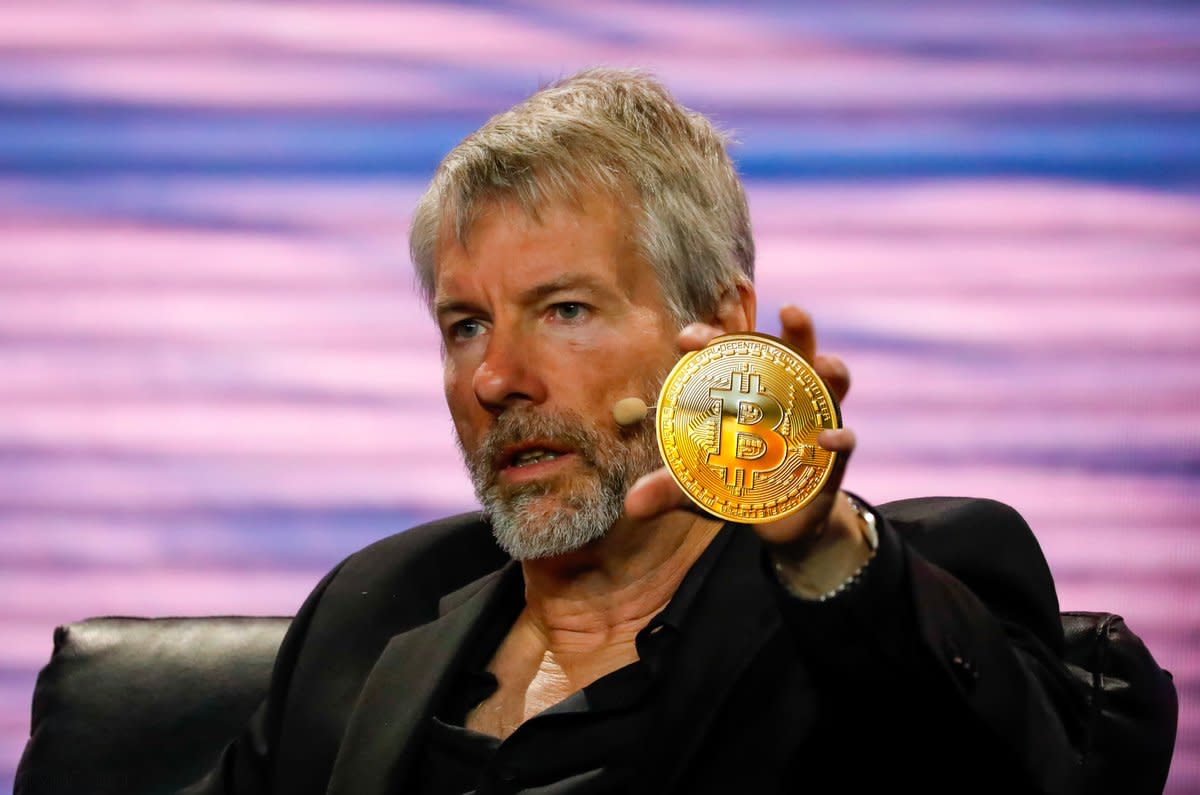Month: April 2024
Dollar gains ahead of Fed meeting; yen hands back some gains
Post Content
Yen jumps against dollar on possible intervention
Post Content
Cryptoverse: TON takes off on Telegram tie-up
Post Content
Asia FX weak as Fed jitters grow, yen stalls after suspected intervention
Post Content
Spot Bitcoin ETFs Commence Trading in Hong Kong
Spot Bitcoin exchange traded funds (ETFs) have officially gone live in Hong Kong as its stock market opens.
OFFICIAL: SPOT #BITCOIN ETFS COMMENCE TRADING IN HONG KONG 
— Bitcoin Magazine (@BitcoinMagazine) April 30, 2024
The approval, eagerly awaited for months, signals a new era for the Bitcoin industry in the region. Major asset managers have been gearing up for this event, after Hong Kong’s Securities and Futures Commission approved three Spot Bitcoin ETF applications earlier this month. China Asset Management, Harvest Global Investments, Bosera International and HashKey, were all among the asset managers gaining regulatory approval to offer these ETFs.
Eric Balchunas and James Seyffart, ETF analysts at Bloomberg, shared the fees for the ETFs in a X post, saying that they were lower than they initially predicted them to be, highlighting this as a “good sign.”
HK spot bitcoin/ether ETFs officially approved to begin trading on April 30th. Fees are 30bps, 60bps and 99bps which is on avg lower than we thought, good sign. We doing an Analyst Q&A in an hour on this w/ local HK team. Register here, bring your qs: https://t.co/GzzCZailx3 https://t.co/AvJ6dv2Xha
— Eric Balchunas (@EricBalchunas) April 24, 2024
These ETFs are anticipated to attract substantial interest from both local and international investors, positioning Hong Kong as a premier destination for Bitcoin investment opportunities.
A Hong Kong spot Bitcoin ETF issuer reportedly told WuBlockchain “the issuance scale of Hong Kong’s Bitcoin and Ethereum spot ETFs, which will be launched tomorrow at UTC+8, is expected to reach US$200 million to US$300 million, exceeding the first-day issuance scale of US$125 million in the United States.”
“China AMC is pretty confident that HK can outdo the US in bitcoin ETF flows and volume on day one. Also says other regions like Singapore and Middle East could seek out the ETFs altho confirmed off limits for China mainland investors,” Balchunas echoed in a similar statement. “Anything close to $125m would be unreal on day one for HK, that’s equivalent of $21b in US!”
Singapore-based Matrixport and Markus Thielen of 10x Research forecast that Hong Kong’s Spot Bitcoin ETFs could potentially unleash up to $25 billion in new demand, underscoring the significant role these financial instruments could play in legitimizing Bitcoin as a mainstream asset class.
As the ETFs go live in Hong Kong, the country also welcomes the Bitcoin Asia Conference, which starts next week, as advertisements for both the conference and the ETFs are now being marketed to residents in the country.
Giant #Bitcoin Asia Conference ad spotted in Hong Kong days after spot Bitcoin ETF approval
Asia is coming
— Bitcoin Magazine (@BitcoinMagazine) April 17, 2024
MicroStrategy Bought 122 Bitcoin In April, Now Holds 214,400 BTC
MicroStrategy, a leading business intelligence and software company, has continued its steadfast commitment to Bitcoin by purchasing an additional 122 BTC in April at a total cost of $7.8 million, Founder & Chairman Michael Saylor announced today.
BREAKING: MicroStrategy bought 122 more #Bitcoin for $7.8 million. pic.twitter.com/IZWUNj0kHY
— Bitcoin Magazine (@BitcoinMagazine) April 29, 2024
“As the world’s first Bitcoin Development Company, MicroStrategy is committed to the continued development of the bitcoin network through our activities in the financial markets, advocacy and technology innovation,” said Phong Le, President and Chief Executive Officer at MicroStrategy. “It is through our unique bitcoin strategy and solid track record as an operating company that we now hold 214,400 bitcoins at an average purchase price of $35,180 per bitcoin.”
The company initially entered the Bitcoin market in August 2020, making a significant initial investment of $250 million into BTC. Since then, they have consistently added to their Bitcoin holdings, creating a treasury reserve strategy that has garnered over 214,400 bitcoin worth more than $15.5 billion at the time of writing.
“In the first quarter we raised over $1.5 billion by executing again on our capital markets strategy including two successful convertible debt offerings,” stated MicroStrategy Chief Financial Officer, Andrew Kang. “We acquired 25,250 additional bitcoins since the end of the fourth quarter, our 14th consecutive quarter of adding more bitcoin to our balance sheet. We believe that the combination of our operating structure, bitcoin strategy, and focus on technology innovation provides a unique opportunity for value creation for our shareholders. Year to date, the price of bitcoin appreciated significantly, spurred notably by the approval of the spot bitcoin exchange traded products which has increased institutional demand and resulted in further regulatory clarity.”
After Bitcoin experienced its fourth halving event less than two weeks ago, halving the mining reward from 6.25 to 3.125 BTC per block, MicroStrategy continues its aggressive BTC investment strategy with no signs of slowing down.
Paypal’s Green Mining Initiative Makes Zero Sense
Last week Paypal released a whitepaper in partnership with Energy Web and DMG Blockchain Solutions, describing a “Green Mining Initiative” intended to redirect fees from participating users specifically to certified miners powering their operations with renewable energy. I can’t say I’m surprised by this honestly, mining has at this point become very normalized in terms of its use to further renewable energy or climate goals. Mining is actually very suited to this task given its nature, miners are mercenaries looking for the cheapest energy possible to devote towards solving the next block. If you have stranded power, or excess power, they will take it.
The overall architecture of this system though is beyond the territory of Rube Goldberg. I am kind of amazed that this is the level of technical understanding and sophistication that a major company like Paypal has on tap, especially in their Blockchain Research Group specifically focusing on this space. The entire thing is inefficient, absurd, and some of the end goals or possibilities they discuss are not built upon sound economic incentives.
The Core Design
The entire gist of the design is to ensure that when a compliant user broadcasts a transaction to the network, only a certified green miner can collect the associated transaction fee. The problem with this is that mining fees from a transaction are collectible from any miner who includes them in a block, not just certified ones. A mechanism is required to guarantee only certain miners can collect a few.
The first thing you have to do is identify which miners you want to be capable of claiming the restricted fee. They propose utilizing a system called “Green Proofs for Bitcoin” offered by Energy Web. The proofs are certifications from the organization that a miners energy mix or impact on the grid meets some threshold of renewable energy use or positive impact on the power grid. In the certification process each miner can register a public key, creating a list of each certified miners public key.
This key certification is at the root of what enables ensuring only the correct miners can claim a fee. Compliant users’ wallets can query or be provided with a list of all certified miners bitcoin addresses, and from there have the information needed to create a special transaction that only they can claim the fee for. The trick is a multisig output. There are no hard limits of how many keys need to sign for a multisig address, so compliant users can include the fee to certified miners in a special output with a 1-of-n multisig script that any certified miner can spend. A minimal fee at the bottom of the mempool feerate range is also included traditionally just to ensure that it propagates across the network.
The last piece of the puzzle is actually claiming the fee. If a certified miner was to mine a block including a green transaction, and not also include a transaction spending the fee output to themselves, then any certified miner could claim the fee output in the next block they mine. There, for each green transaction a certified miner includes in their block, they must include a corresponding transaction sending the fee output to an address only they hold a key for.
Special wallets can craft transactions with fee outputs only claimable by certified miners, and these users can preferentially direct their fees towards miners certified as using renewable energy or creating some other positive impact on the grid.
Full of holes and incomplete thinking
Firstly, the general idea of requiring miners to include a second transaction of their own is an incredibly inefficient design, which they do acknowledge in the paper. What they don’t acknowledge is the economic realities this implies for transactions’ feerates.
A Bitcoin transaction pays fees based on the amount of space it takes up in terms of data. By introducing the need for miners to take up blockspace creating a secondary transaction collecting this “green fee” they are economically speaking increasing the size of the green transaction itself. This is very similar in practice to Child-Pays-For-Parent from an economic perspective.
With CPFP, a transaction spending an output from an unconfirmed transaction pays an abnormally high fee. This by averaging the fee the second transaction pays across both itself and the first transaction, which must be confirmed before the second one can be, increases the feerate of the first transaction. This green fee collection mechanism is the same dynamic, but in reverse.
By requiring the miners to craft a second transaction to claim the fee, assuming the fee output pays an average feerate, the net fees the miner collects per byte of data is actually lowered. The blockspace required to collect it could have been used to include another fee paying transaction. So in reality, the fee a compliant user includes for certified miners must also pay for the miner’s claim transaction, in effect meaning compliant users have to pay more absolute fees to achieve a specific fee rate. Why would users do this?
In a vacuum this dynamic guarantees that either compliant users have to overpay, or certified miners wind up actually making less revenue all things equal. The former is irrational from a consumer point of view, and the latter completely fails to achieve the goal of rewarding miners using renewables extra revenue.
A second glaring issue, and an amazing one, is their thinking of how to structure the 1-of-n multisig script. With traditional pre-Taproot multisig, each individual key in the multisig must be present in the script. This presents a problem. The size of the green fee output grows linearly for each miner who has a key in the multisig.
The plan laid out in the paper describes breaking miners up into subgroups, and rotating between which group you pay fees to each time you transact. I.e. if there are 21 miners, split them up into 3 groups of 7, moving to the next group to send the fees to each time you transact. This would create a highly irregular distribution of fees between all the certified miners, as the rate of transactions amongst compliant users and rate of rotation between them is not something that can be prescribed or made regular. Not to mention, it seemingly shows a complete lack of awareness of Schnorr based multisig schemes like FROST.
Schnorr based multisig scripts use aggregate keys, meaning no matter how many member keys are involved, only a single public key is needed for the script, and only a single signature is required. This would completely address the issue of multisig script size, and do away with the requirement for the clunk breaking up of certified miners into subgroups.
They also make no mention of more efficient mechanisms for actually collecting the fee. A single secondary transaction for each green transaction is mind blowingly inefficient. An very obvious mechanism to be more efficient with use of blockspace would be to sweep all of the green transaction fee outputs in a single transaction. This would require only a single transaction output to aggregate all of the fees into a single UTXO, rather than a discrete output for each individual fee, and also creating the need to combine them with yet another transaction later.
They finally go on to discuss the potential of a centralized out of band mechanism directly to certified miners, but bring up the centralization, introduction of trust, and complexity of implementing direct communication to each individual miner as reasons for designing the distributed protocol described above.
The Market Alright Does This
At the end of the day, the technical inefficiencies and lack of grasping blatantly obvious solutions (at least partially) to them, aren’t even the most confounding part of this to me. It’s attempting to insert incentive distorting dynamics into the application layer of the protocol to address the concern over renewable energy in the first place. Why? The market literally handles this incentive all by itself.
https://en.wikipedia.org/wiki/File:Electricity_costs_in_dollars_according_to_data_from_Lazard.png
Renewable energy is the cheapest energy even when taking into account the cost of construction and operation of energy production capacity. Miners chief concern is finding the lowest priced energy they possibly can. Why is Paypal trying to interject weird systems giving users a distortionary mechanism to restrict fees only to certain miners, and overall introduce a distortionary market mechanism into this picture? The market already does what you want. Renewable energy is cheap, build more of it and miners will come and buy it, bringing revenue to finance the operation (especially when it is initially disconnected from the grid and has no other consumers).
The entire dynamic of fees in Bitcoin is that it is a completely open market, where any miner can compete to collect fees from any transaction by including them in their own blocks. This entire dynamic is built to incentivize maximal competition between miners to provide security and finality to users of the network. Trying to introduce weird distortions like this proposal into the system is a destabilizing factor in the balance of competition and network security, and is completely redundant given the market realities of the mining ecosystem.
Do you want to see Bitcoin mining be a positive factor in incentivizing and helping expand renewable energy production? Great! It already does that, no changes needed. It does not need Rube Goldberg machinations slapped on top to accomplish that goal, the inherent market based mechanisms of competition between miners already does that.
I really don’t understand what Paypal, DMG, and Energy Web are thinking here.
Experts, politicians call for scrutiny of Venezuela’s use of cryptocurrency
Post Content
Samourai Wallet: Breaking Down Dangerous Precedents
On Wednesday, the founders of the Bitcoin privacy wallet Samourai Wallet were arrested and charged on behalf of the US Government. The indictment could set dangerous precedents beyond Bitcoin privacy services.
“If your government is worried about their own citizens controlling their money, the most important question you have to ask is ‘what the hell is wrong with my government’”
– Andreas Antonopolous
Last wednesday, Samourai Wallet founders Keonne Rodriguez and William Hill were arrested and charged with conspiracy to money laundering and conspiracy to operate an unlicensed money service business in the Southern District Court of New York. The indictment alleges that Samourai Wallet “facilitated more than $100 Million in money laundering transactions from illegal dark web markets”.
The definition of a non-custodial wallet as a money service business and the consequent indictment of the wallet’s maintainers can set dangerous precedents for the wider Bitcoin space and may go as far as affecting the freedom of the internet, essentially endangering all individuals, organizations and technologies involved in the transfer of financial transactions without exercising control over funds.
Can a non-custodial wallet be a money service business?
FinCEN’s 2019 guidance on persons administering, exchanging, or using virtual currencies, define a money transmitter as a “person that provides money transmission services,” or “any other person engaged in the transfer of funds.” As the guidance states, “a transmitter initiates a transaction that the money transmitter actually executes.”
The guidance further states that “the term “money transmission services” is defined to mean the acceptance of currency, funds, or other value that substitutes for currency from one person and
the transmission of currency, funds, or other value that substitutes for currency to another location or person by any means.”
As a non-custodial Bitcoin wallet, Samourai Wallet’s operators do not take custody of user funds and therefore are technically incapable to “accept” deposits or “execute” the transmission of funds, contrarily to what is alleged by prosecutors, stating that “Samourai engaged in the unlicensed receipt
and transmission of funds, including funds deposited into a Samourai wallet by an undercover law enforcement agent located in the Southern District of New York.”
However, technically speaking, the agent deposited funds into an application running locally on his device, with no engagement from Samourai operators – a circumstance correctly noted by prosecutors throughout the indictment, stating that “the private keys for these cryptocurrency addresses are stored in each user’s individual cell phone”, that “these private keys are not shared with Samourai employees,” and that “the Samourai software on the user’s cellphone will broadcast a transaction to the blockchain.”
The indictment yet alleges that Samourai Wallet “facilitates transactions between Samourai users” – a claim that seems blatantly incorrect in the face of the fact that coinjoin transactions do not facilitate transactions between users at all, but rather create a shared transaction in which every user spends their own funds to themselves.
The indictment further repeatedly alleges that Samourai creates “new addresses” used during the transactions, and that “The Samourai server is responsible” for broadcasting transactions – claims which, too, are technically incorrect as transactions are created solely on the users device and Samourai only broadcasts transactions on behalf of users if users choose to broadcast their transactions via Samourai’s node. For anyone running their own node with Samourai Wallet, known as “Dojo”, transactions are broadcast by users themselves.
Numbers provided by the node provider Ronin Dojo suggest that up to 85% of Whirlpool users run their own Dojo. It is questionable whether organized criminals would rely on nodes provided by Samourai Wallet as its operators would effectively be enabled to deanonymize transactions by gaining knowledge of users’ extended publickeys, a design choice often criticized in Samourai Wallet’s architecture. Notably, the indictment makes no mention of “Dojo” at all.
DoJ Challenges FinCEN Guidelines
The indictment against Samourai appears to suggest that the DoJ does not believe FinCEN guidelines apply as reflected in the language used to describe Samourai’s services, in which prosecutors note the broadcasting of transactions, the operation of a centralized server, and the subsequent collection of fees from the services offered:
“The Samourai server is responsible for broadcasting the Ricochet transactions to the BTC network […] From Whirlpool and Ricochet, RODRIGUEZ and HILL earned at least $4 million in fees”
The DoJ’s arguments appear more in line with recent recommendations issued by the financial action task force. FATF, an intergovernmental body established by the G7 in 1989 to combat money laundering and terrorist financing risks, is not a regulatory body, but the task force’s recommendations are known to form the basis of informing AML/CFT regulations around the world.
In recommendations issued in 2021, FATF expands the definition of virtual asset service providers as “decentralized exchanges or platforms” which “have a central party with some measure of involvement or control,” such as developing “user interfaces for accounts holding an administrative “key”” or “collecting fees.”
By the logic put forward by FATF, it appears that the development of any individual, organization or technology interfacing with financial transactions could require a money service business license. Notably, a new AML package adopted by the European Parliament last week aimed at updating current AML regulations in accordance with FATF recommendations, specifically exempted self-custodial services.
Similar attempts to circumvent FinCEN guidelines are currently being made on the Tornado Cash case. In an opposition issued on April 26th, prosecutors argue that the definition of money transmitting “does not require the money transmitter to have “control” of the funds being transferred,” highlighting that Section 1960 of US Code, a codification of permanent federal laws, extends the definition of money transmitting to “transferring funds on behalf of the public by any and all means.”
As interpreted by the department of justice, AT&T would require a money service business license to allow customers access to their PayPal, an ISP would need a money service business license to allow users to access online banking services, a postman would require a money service business license to deliver cash in mail, a grocer would need a money service business license to hand out change, and Telegram, WhatsApp, Signal and X (formerly Twitter) would require a money service business license if users utilize the platform to share PSBTs or lightning invoices – subsequently deeming all such services to require full know your customer verification.
Can the Bitcoin Network be KYCed?
The indictment has sent ripples through the Bitcoin ecosystem, leaving anyone involved in the broadcasting of Bitcoin transactions in uncertainty, including bitcoin miners and node operators. The non-custodial Lightning wallet Phoenix has since announced the suspending operations in the US. The privacy-first Bitcoin wallet Wasabi Wallet has banned US users from accessing its services and software.
Reading the indictment, it appears as though everything we knew about the regulatory aspects of money transmission may have been misapplied, as the indictment appears to go as far as to attempt the criminalization of self-spending. As the indictment reads, self-spends, as evident in coinjoins and Samourai’s Ricochet, “further obscure ownership of the funds.” But any Bitcoin wallet allows users to generate self-spends and essentially circumvent blockchain surveillance mechanisms and censorship, further muddying regulatory waters.
The foundations to introduce KYC to the Bitcoin network have been researched as early as 2016 with the MIT ChainAnchor project, which explored the introduction of identities and permission groups to blockchains, preventing non-registered users from having transactions mined in blocks.
With increasing miner centralization, with around 47% of hashrate’s mining rewards custodied by a single custodian, including the pools of AntPool, F2Pool, Binance Pool, Braiins, btcom, SECPOOL, and Poolin, plans to KYC the Bitcoin network may not seem too far fetched. In 2023, F2Pool already began censoring transactions in line with the OFAC sanctions list.
Since the indictment of the Samourai founders, the FBI has issued a PSA concerning cryptocurrency money service businesses, alerting the public to avoid services which do not require know your customer information.
If the non-custodial operation of services is ruled to classify as money transmission, the doors could be open to KYCing any service operating communication protocols, from Nostr to WiFi hotspots and telecommunication providers. If spun ad absurdum, it could even be argued to require the registration of KYC for the use of highways or the purchase of briefcases.
Plans to KYC the internet have been around since as early as 2014, when the US Government attempted to introduce a “drivers license for the internet,” similar to the planned introduction of digital identities around the world.
It should be noted that the treatment of Samourai founders, who are currently serving pre-trial detention, stands in no comparison to the handling of financial crime allegations around the world. Since 2000, traditional financial institutions, such as UBS, JP Morgan, and Bank of America, have been fined over $380 Billion. The argument that traditional banks are primarily used for legal transactions can also be applied to Samourai Wallet, as the indictment reportedly only alleges the transmission of illicit funds of 3.6% of Samourai’s total transaction volume, leaving 96.4% of legitimate usage.
The Samourai case has been assigned to judge Richard M. Berman, who previously presided over the the Jeffrey Epstein case. In 2005, Berman ruled that random police searches of riders bags on the New York City subway did not violate the U.S. constitution.
This is a guest post by L0la L33tz. Opinions expressed are entirely their own and do not necessarily reflect those of BTC Inc or Bitcoin Magazine.
Japan’s yen surges against dollar on suspected intervention
Post Content









